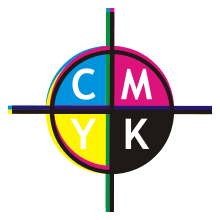Printing registration

In color printing, registration is the method of correlating overlapping colors on one single image. There are many different styles and types of registration, many of which employ the alignment of specific marks.
Purpose
When printing an image that has more than one color, it is necessary to print each color separately and ensure each color overlaps the others precisely. If this is not done, the finished image will look fuzzy, blurred or "out of register" (see image to right). To help line the colors up correctly, a system of registration is necessary.
Types of (stone) lithography registration

There are many different styles of registration for many different types of printing. These deal with stone lithography, as used in fine arts printmaking.[1]
T-bar
This method, using small measured registration marks on both the stone and the paper, is very accurate and simple to do. The printer measures the exact size of the paper and the desired margins. Then marks are made at both ends of the sheet of paper, and corresponding marks (usually in the shape of a "T") are made on the stone. Then the printer matches the marks on the paper to those on the stone. This way many runs of different colors can be pulled exactly in line with one another, each of them measured from the same system of marks.
Pin-hole
This method involves laying the paper on the un-inked surface, and making a pin-hole through both the bottom and top of the paper, being careful to make a mark in the stone's surface. Then the locations of the holes are transferred to each sheet of paper to be printed. When printing, one should place pins in each hole of a sheet of paper, and lower it onto the inked stone, placing each pin in its respective hole in the stone. This method can ruin paper by creating holes. And if the holes get too large, they lose their function as registration devices.
Eye-balling

This method relies solely on hand–eye coordination. The printer places the paper over the stone-image, measuring and judging registration by eye. This is not very consistent, depending on the person.
References
- ↑ Ross, Romano, Ross. "The Complete Printmaker", Page 226. The Free Press, 1990